Cooperative Data Collection Mechanism Using Multiple Mobile Sinks in Wireless Sensor Networks
Abstract
:1. Introduction
- Achieving the purpose of cooperative data collection. The proposed CDCA partitions the data collection task into k subtasks through benefit calculations. The mobile sinks can cooperatively collect data along the constructed paths.
- Prolonging network lifetime. The proposed CDCA considers the forwarding workload of each sensor, selects the k sensors with the largest forwarding workloads and then partitions a tree with n sensors into k subtrees. This can minimize the energy consumption of sensors with maximal energy consumption and hence prolong the network lifetime.
- Balancing the workloads of sensors for packet forwarding in each subset. The proposed mechanism considers the length cost between any two consecutive CPs. Therefore, the established route allows the mobile sink to visit more collection points. Compared with weighted rendezvous planning (WRP) [15], the proposed CDCA distributes the workloads of data forwarding to more collection points, prolonging the network lifetime.
- Maintaining a stable cycle for the rendezvous opportunities between each local mobile sink and global sink. The proposed mechanism adjusts the velocities of the mobile sinks to ensure that each local mobile sink and the global sink can have stable rendezvous time periodically.
2. Related Work
3. Network Environment and Problem Formulation
3.1. Network Environment
3.2. Problem Formulation
4. The Proposed CDCA Algorithm
4.1. Network Partition Phase
| Algorithm 1. Balanced Tree Partition (BTP) Algorithm. |
| Input: , ; |
| Output: A set of balanced subtree |
| 1. ={sink} |
| 2. While (){ |
| 3. Evaluate according to Equation (10), for each ; |
| 4. Evaluate , according to Equation (11), for each ; |
| 5. Evaluate ; |
| 6. |
| 7. |
| 8. ; |
| 9. Reconstruct k subtrees |
| 10. } |
| 11. Let = numbers of nodes in subtrees , for I ; |
| 12. ; |
| 13. For (z = 1; z <= k; z ++){ |
| 14. If ({ |
| 15. |
| 16. T=T − } |
| 17. Else { |
| 18. ; |
| 19. |
| 20. If ( and are neighboring trees) |
| 21. |
| 22. Remove the edge linking from ; |
| 23. Connecting pointto the nearest node in;}} |
| 24. |
4.2. CP Selection and Path Construction Phase
4.3. Speed Control Phase
5. Performance Evaluations
6. Conclusions
Author Contributions
Funding
Conflicts of Interest
References
- Suryadevara, N.-K.; Mukhopadhyay, S.-C. Wireless sensor network based home monitoring system for wellness determination of elderly. IEEE Sens. 2012, 12, 1965–1972. [Google Scholar] [CrossRef]
- Kolba, M.P.; Scott, W.R.; Collins, L.M. A framework for information-based sensor management for the detection of static targets. IEEE Trans. Syst. Man Cybern. Part A Syst. Hum. 2011, 41, 105–120. [Google Scholar] [CrossRef]
- Mainwaring, A.; Polastre, J.; Szewczyk, R.; Culler, D.; Anderson, J. Wireless sensor networks for habitat monitoring. In Proceedings of the 1st ACM international workshop on Wireless sensor networks and applications, Atlanta, GA, USA, 28 September 2002; pp. 88–97. [Google Scholar]
- Zeng, Y.; Sreenan, C.J.; Sitanayah, L.; Xiong, N.; Park, J.; Zheng, J.H. An emergency-adaptive routing scheme for wireless sensor networks for building fire hazard monitoring. Sensors 2011, 11, 2899–2919. [Google Scholar] [CrossRef] [PubMed]
- Pan, M.-S.; Yeh, L.-W.; Chen, Y.-A.; Lin, Y.-H.; Tseng, Y.-C. A WSN-based intelligent light control system considering user activities and profiles. IEEE Sens. 2008, 8, 1710–1721. [Google Scholar] [CrossRef]
- Keung, G.Y.; Li, B.; Zhang, Q. The intrusion detection in mobile sensor network. IEEE/ACM Trans. Netw. 2012, 20, 1152–1161. [Google Scholar] [CrossRef]
- Zhang, Y.; Sun, X.; Wang, B. Efficient algorithm for k-barrier coverage based on integer linear programming. China Commun. 2016, 13, 16–23. [Google Scholar] [CrossRef]
- Gao, D.; Lin, H.; Liu, Y.; Jiang, A. Minimizing end-to-end delay routing protocol for rechargeable wireless sensor network. Ad Hoc Sens. Wirel. Netw. 2016, 34, 77–98. [Google Scholar]
- Shah, R.; Roy, S.; Jain, S.; Brunette, W. Data mules: Modeling and analysis of a three-tier architecture for sparse sensor networks. Ad Hoc Netw. 2003, 1, 215–233. [Google Scholar] [CrossRef]
- Azizi, R. Consumption of energy and routing protocols in wireless sensor network. Netw. Protoc. Algorithms 2016, 8, 76–87. [Google Scholar] [CrossRef]
- Ma, M.; Yang, Y. Data gathering in wireless sensor networks with mobile collectors. In Proceedings of the 2008 IEEE International Symposium on Parallel and Distributed Processing, Miami, FL, USA, 14–18 April 2008; pp. 1–9. [Google Scholar]
- Sugihara, R.; Gupta, R.K. Optimal speed control of mobile node for data collection in sensor networks. IEEE Trans. Mobile Comput. 2010, 9, 127–139. [Google Scholar] [CrossRef]
- Somasundara, A.A.; Ramamoorthy, A.; Srivastava, M.B. Mobile element scheduling with dynamic deadlines. IEEE Trans. Mobile Comput. 2007, 6, 395–410. [Google Scholar] [CrossRef]
- Yang, Y.-H.; Lin, T.; Liu, B.-H.; Chu, S.-I.; Lien, C.-Y.; Pham, V.-T. An efficient mobile sink scheduling method for data collection in wireless sensor networks. In Proceedings of the 2017 International Conference on System Science and Engineering (ICSSE), Ho Chi Minh City, Vietnam, 21–23 July 2017; pp. 554–557. [Google Scholar]
- Salarian, H.; Chin, K.-W.; Naghdy, F. An energy-effcient mobile-sink path selection strategy for wireless sensor networks. IEEE Trans. Veh. Technol. 2014, 63, 2407–2419. [Google Scholar] [CrossRef]
- Zhao, M.; Ma, M.; Yang, Y. Efficient data gathering with mobile collectors and space-division, multiple access technique in wireless sensor networks. IEEE Trans. Comput. 2011, 60, P400–417. [Google Scholar] [CrossRef]
- Aslanyan, H.; Leone, P.; Rolim, J. Data propagation with guaranteed delivery for mobile networks. In Proceedings of the 9th International Conference on Experimental Algorithms, Naples, Italy, 20–22 May 2010; pp. 386–397. [Google Scholar]
- Sivakumar, B.; Sowmya, B. An energy efficient clustering with delay reductionn in data gathering (EE-CDRDG) using mobile sensor node. Wirel. Pers. Commun. 2016, 90, 793–806. [Google Scholar] [CrossRef]
- Freitas, E.; Heimfarth, T.; Vinel, A.; Wagner, F.; Pereira, C.; Larsson, T. Cooperation among wirelessly connected static and mobile sensor nodes for surveillance applications. Sensors. 2013, 13, 12903–12928. [Google Scholar] [CrossRef]
- Le, D.V.; Oh, H.; Yoon, S. HiCoDG: A hierarchical data-gathering scheme using cooperative multiple mobile elements. Sensors 2014, 14, 24278–24304. [Google Scholar] [PubMed]
- Sandra, S.; Lloret, J.; García, M.; Toledo, J. Power saving and energy optimization techniques for wireless sensor networks. J. Commun. 2011, 16, 439–459. [Google Scholar]
- Wen, W.M.; Zhao, S.H.; Shang, C.J.; Chang, C.Y. EAPC: Energy-Aware Path Construction for Data Collection using Mobile Sink in Wireless Sensor Network. IEEE Sens. J. 2018, 18, 890–901. [Google Scholar] [CrossRef]
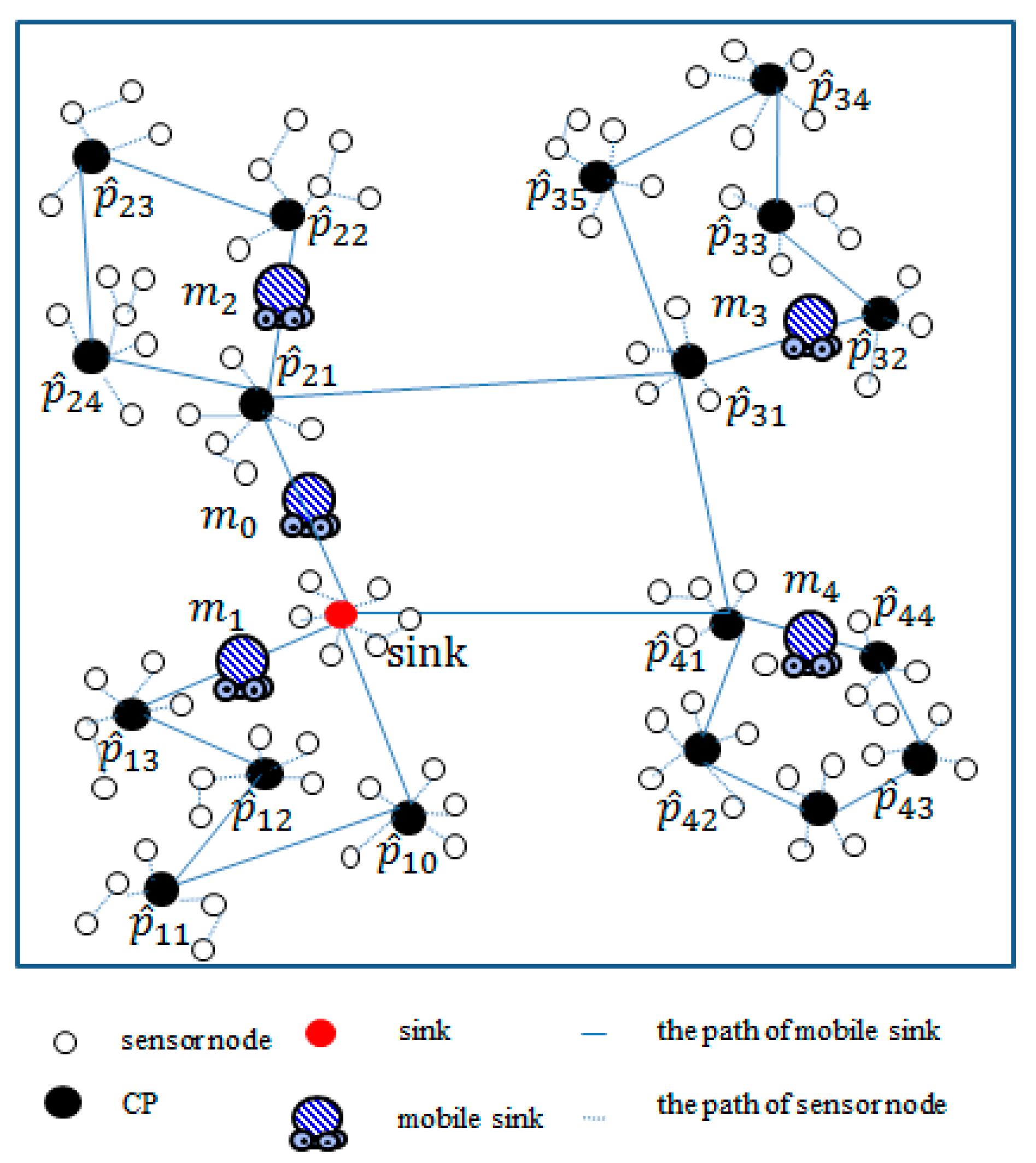


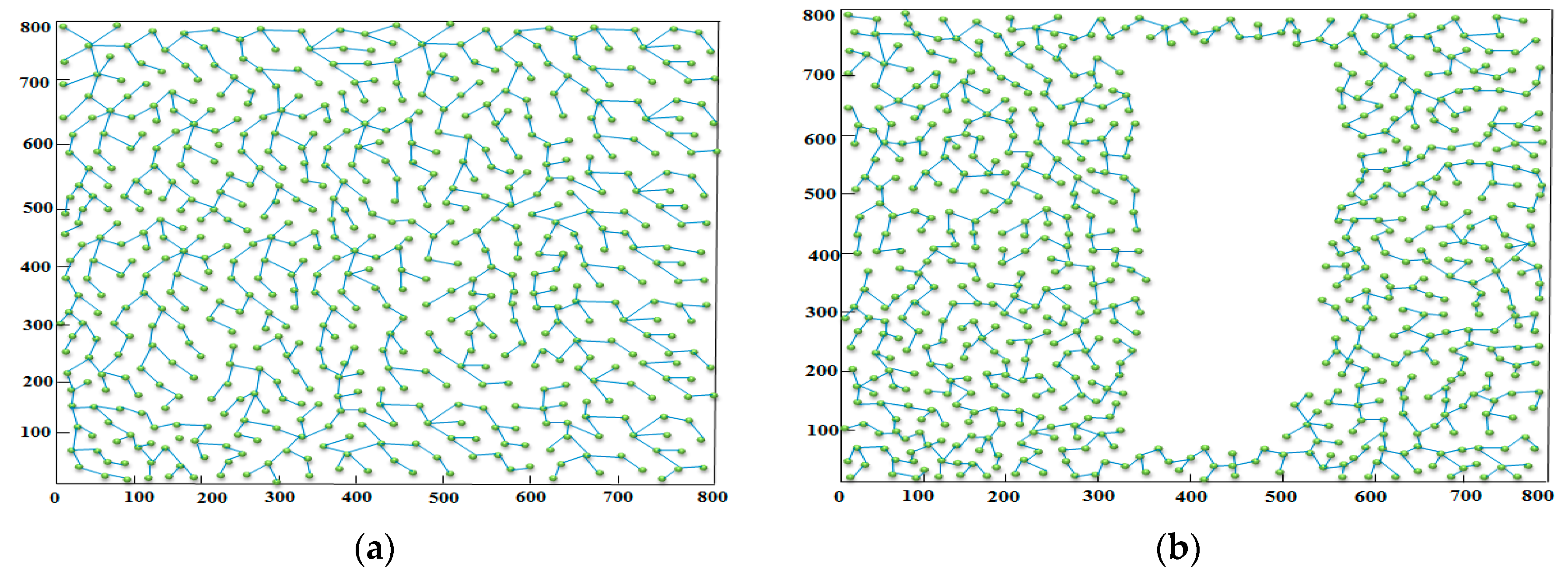
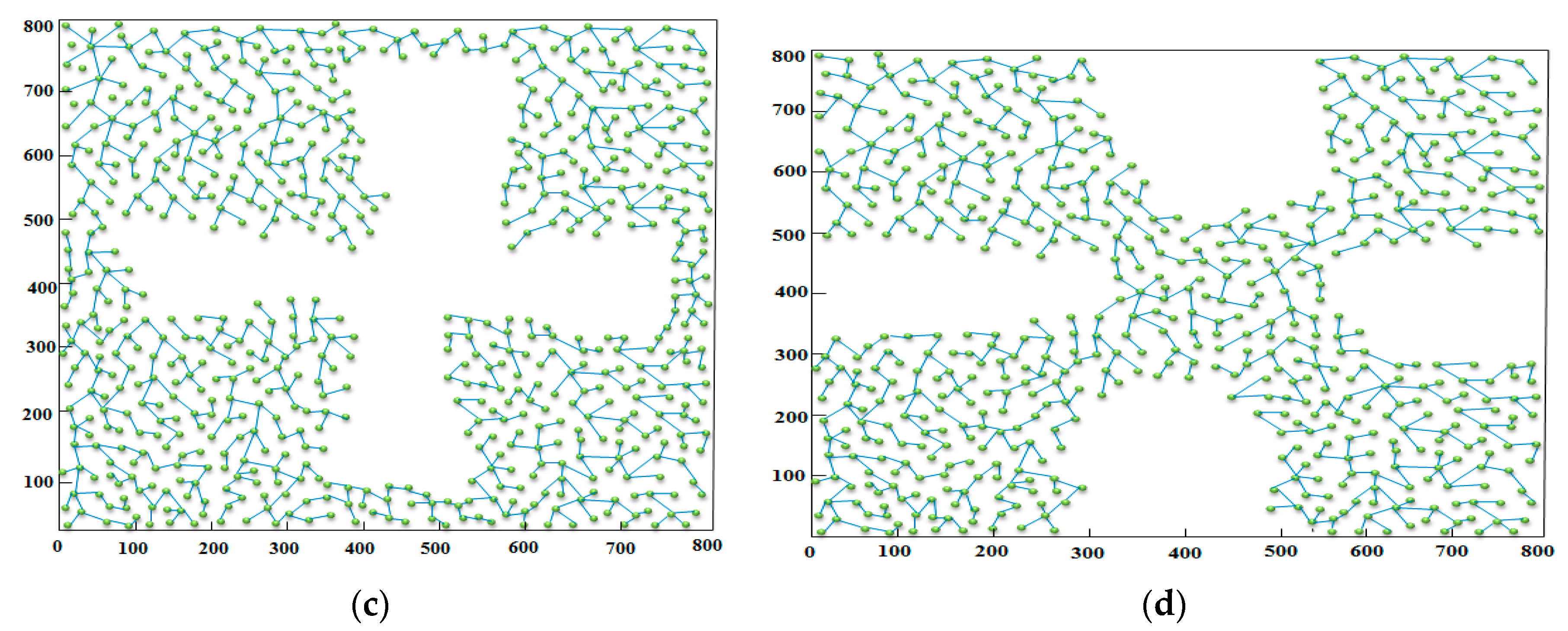

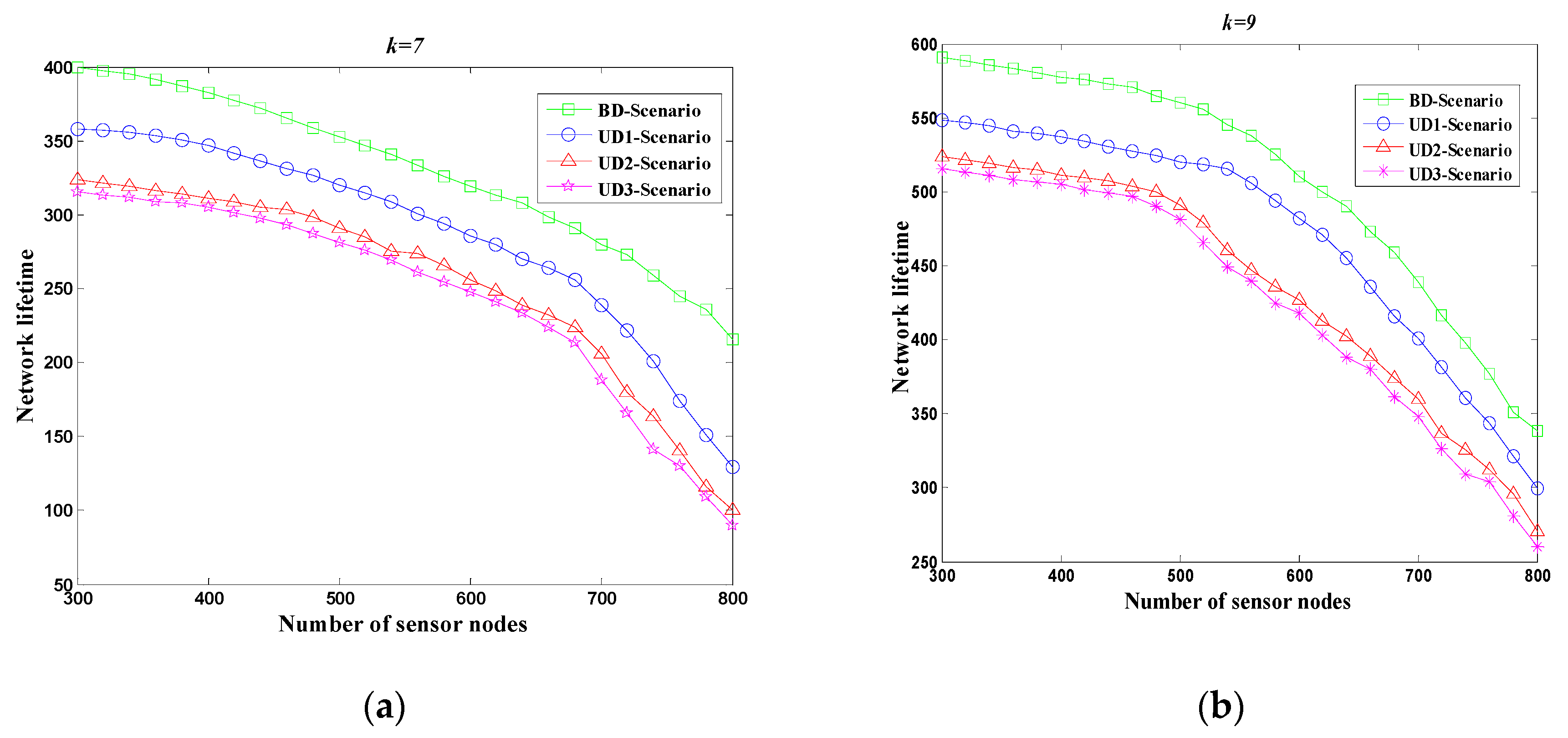
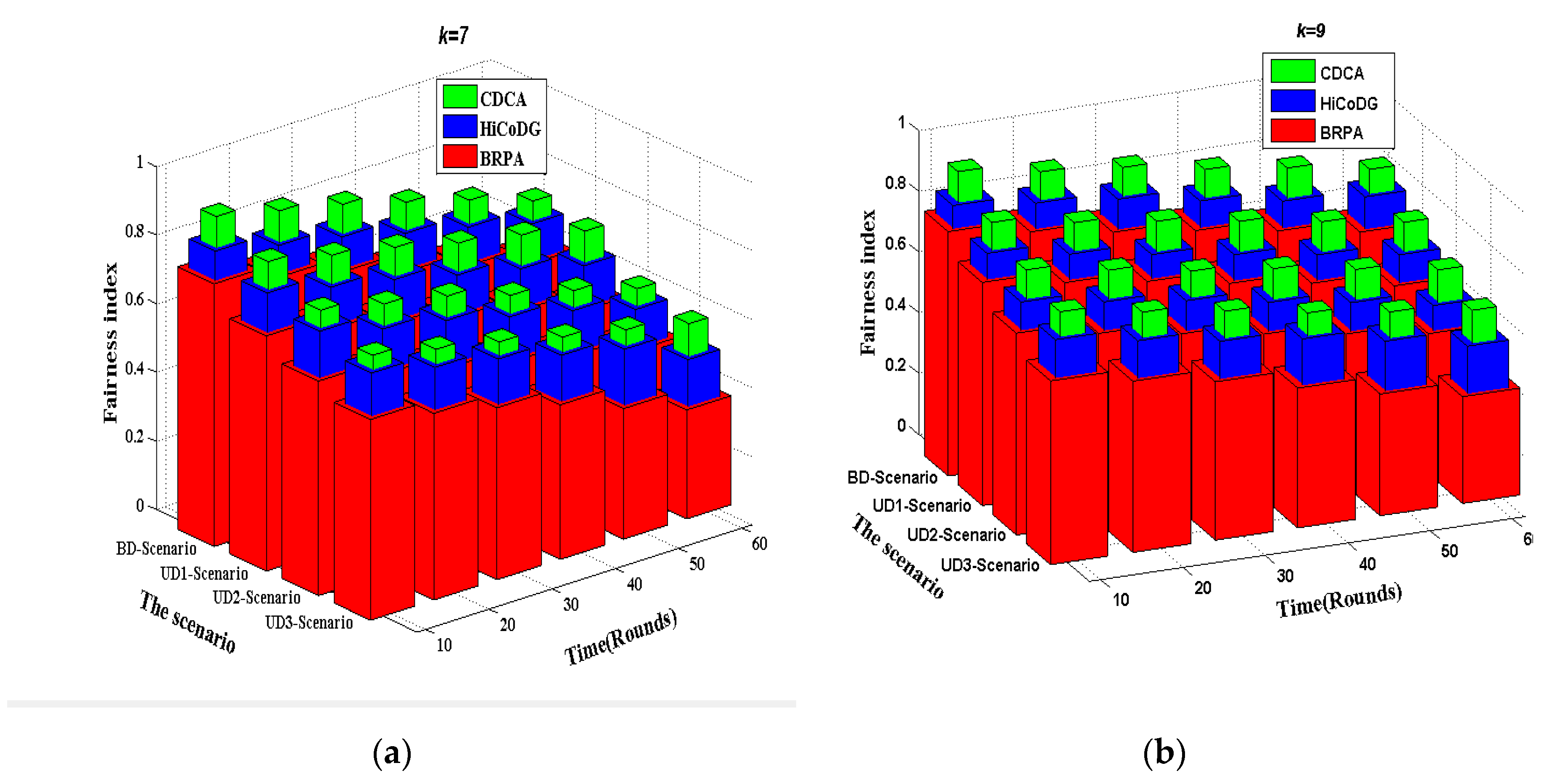
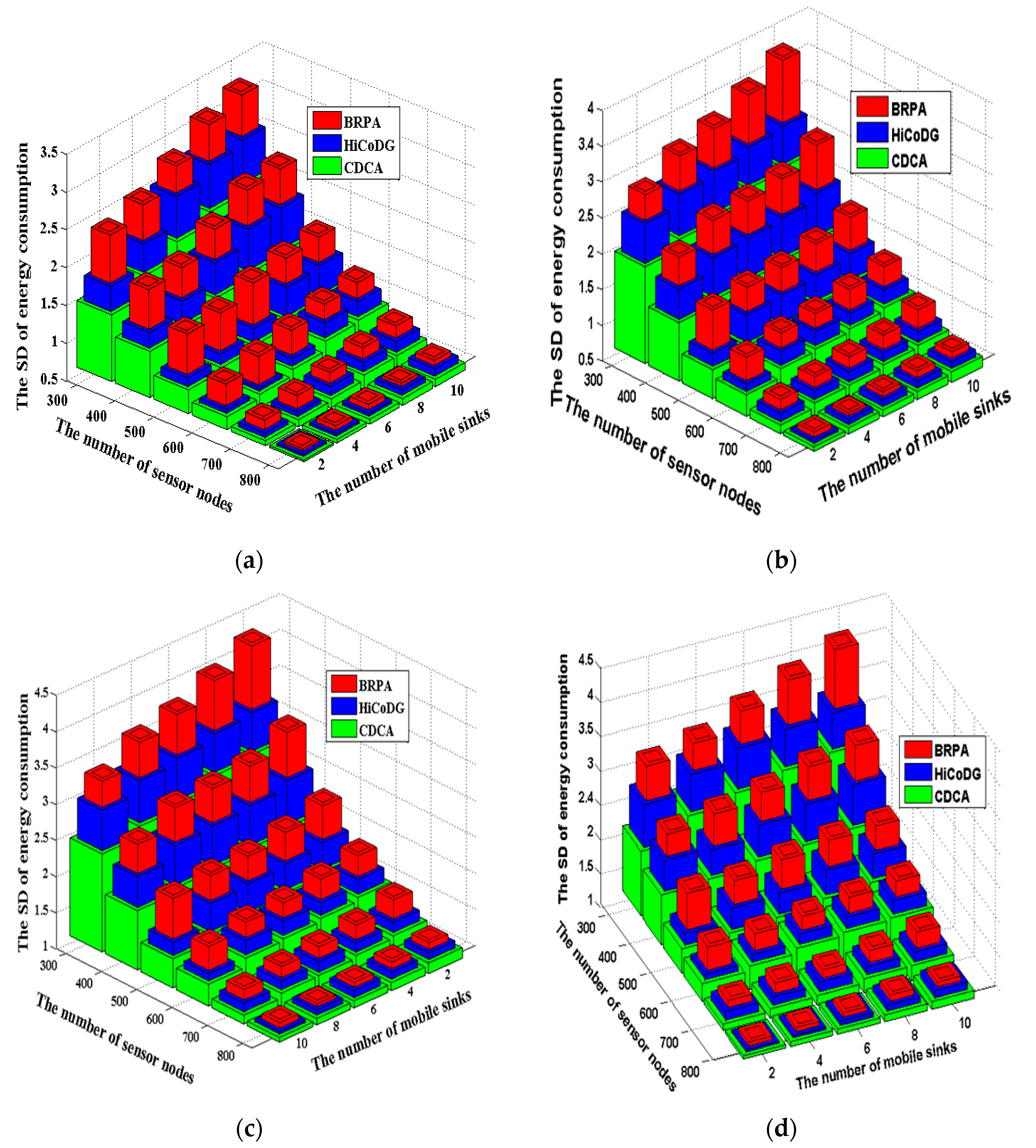
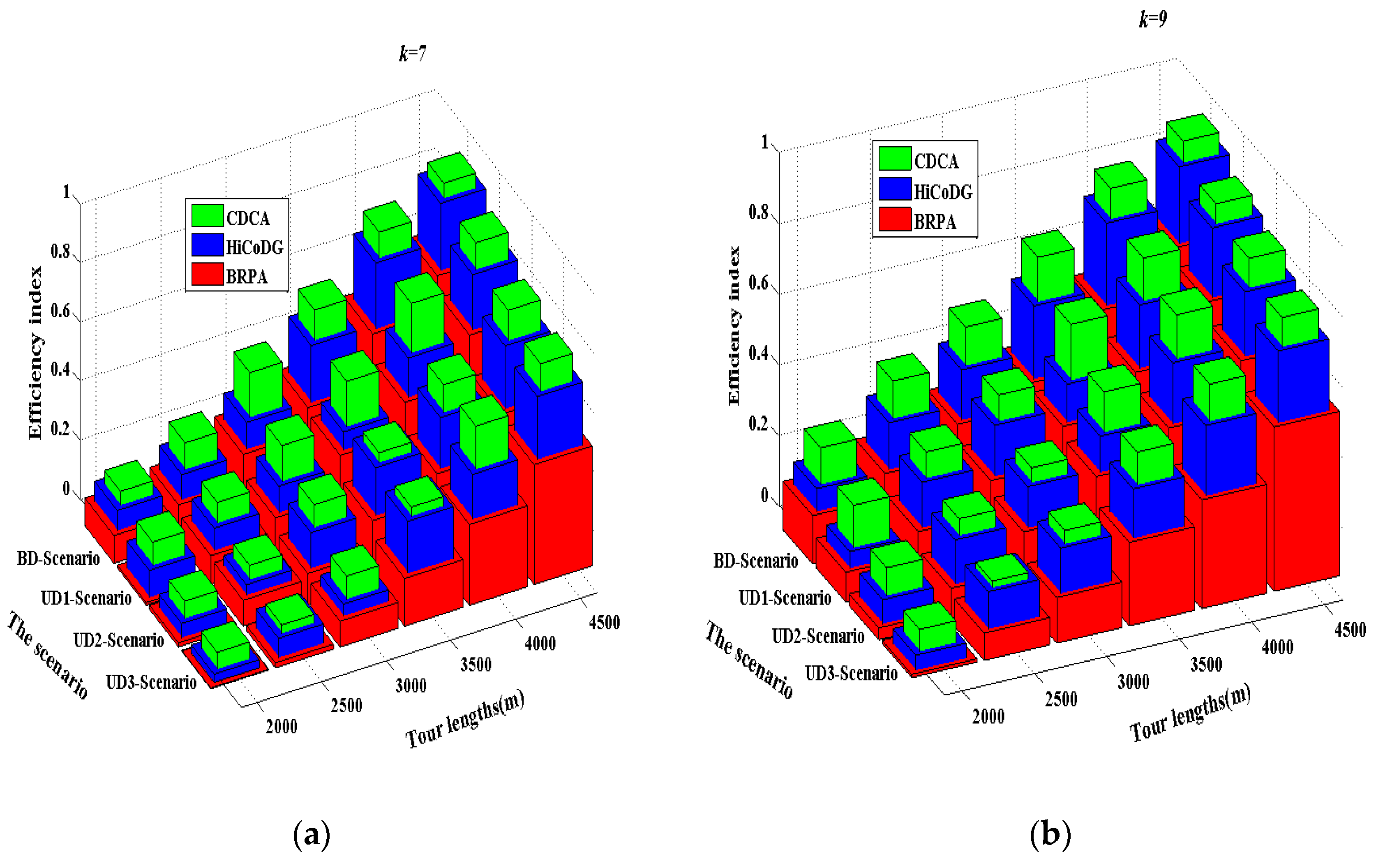
| Studies | Number of Mobile Sink | Path Construction | Data Collection Latency | Mobile Sinks Cooperation |
|---|---|---|---|---|
| [14] | single | O | long | × |
| [15] | single | O | long | × |
| [16] | multiple | O | short | × |
| [17] | multiple | × | long | O |
| [18] | multiple | × | short | × |
| [19] | multiple | × | short | × |
| [20] | multiple | O | short | O |
| The proposed CDCA | multiple | O | short | O |
| Parameter | Value |
|---|---|
| Node deployment | Uniform random distribution |
| Given region | 800 m × 800 m |
| The number of sensor node | 600–800 |
| Mobile sink speed | 3 m/s |
| Sensor node transmission range | 30 m |
| Consumed energy in transmitter circuit | 0.18 J |
| Consumed energy at the receiver circuit | 0.1 J |
© 2018 by the authors. Licensee MDPI, Basel, Switzerland. This article is an open access article distributed under the terms and conditions of the Creative Commons Attribution (CC BY) license (http://creativecommons.org/licenses/by/4.0/).
Share and Cite
Wen, W.; Chang, C.-Y.; Zhao, S.; Shang, C. Cooperative Data Collection Mechanism Using Multiple Mobile Sinks in Wireless Sensor Networks. Sensors 2018, 18, 2627. https://doi.org/10.3390/s18082627
Wen W, Chang C-Y, Zhao S, Shang C. Cooperative Data Collection Mechanism Using Multiple Mobile Sinks in Wireless Sensor Networks. Sensors. 2018; 18(8):2627. https://doi.org/10.3390/s18082627
Chicago/Turabian StyleWen, Weimin, Chih-Yung Chang, Shenghui Zhao, and Cuijuan Shang. 2018. "Cooperative Data Collection Mechanism Using Multiple Mobile Sinks in Wireless Sensor Networks" Sensors 18, no. 8: 2627. https://doi.org/10.3390/s18082627





